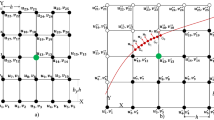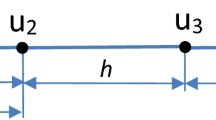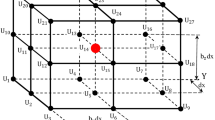Abstract
The review of the optimal local truncation error method (OLTEM) for the numerical solution of PDEs is presented along with some new developments of OLTEM. First, we explain the basic ideas of OLTEM for the 1-D wave equation and then we extend them to the time-dependent PDEs (the scalar wave and heat equations as well as a system of the elastodynamics equations) and to the time-independent PDEs (the Poisson and Helmholtz equations as well as a system of the elastostatics equations) in the 2-D and 3-D cases for homogeneous, inhomogeneous and heterogeneous materials. The main advantages of OLTEM are the optimal (maximum possible) accuracy of discrete equations and the use of unfitted Cartesian meshes for irregular domains and interfaces. For example, for heterogeneous materials with irregular interfaces, OLTEM with 2-D 25-point stencils (similar to those for quadratic finite elements) provides the 11-th and 10-th orders of accuracy for the Poisson and elasticity equations, i.e, a huge increase in accuracy by 8 and 7 orders compared to quadratic finite elements without additional computational costs. Another advantage of OLTEM is a special procedure for the imposition of the boundary and interface conditions without the introduction of additional unknowns. These conditions at a small number of the selected boundary and interface points are added to the local truncation error as the constraints with Lagrange multipliers. This special procedure does not introduce additional unknowns on the boundaries and interfaces (only the unknowns at internal Cartesian grid points are used), does not change the width of cut stencils, allows unfitted meshes and provides a high accuracy of cut stencils. For time-dependent PDEs, OLTEM offers a rigorous approach for the calculation of the diagonal mass matrix in terms of the coefficients of the stiffness matrix that is based on the accuracy considerations. A new OLTEM post-processing procedure for the calculation of the spatial derivatives of the primary function that is based on the use of original PDEs significantly increases the accuracy of the spatial derivatives. For example, we have obtained the 10-th order of accuracy for stresses calculated by OLTEM with 25-point stencils applied to 2-D elastostatics problems with heterogeneous materials and irregular interfaces. New developments of OLTEM related to numerical high-order boundary conditions for cut stencils as well as to the accurate calculation of the primary functions and their derivatives at any point of the domain are presented. The comparison of accuracy of OLTEM and FEM at similar stencils is also analyzed. Numerical results show that at the engineering accuracy, OLTEM can reduce the number of degrees of freedom by 1000-1,000,000 times compared to that for finite elements at similar stencils.













Similar content being viewed by others
References
Idesman A, Dey B (2020) New 25-point stencils with optimal accuracy for 2-d heat transfer problems. Comparison with the quadratic isogeometric elements. J Comput Phys 418:109640
Idesman A, Dey B (2020) Compact high-order stencils with optimal accuracy for numerical solutions of 2-d time-independent elasticity equations. Comput Methods Appl Mech Eng 360:112699
Idesman A, Dey B, Mobin M (2022) The 10-th order of accuracy of ‘quadratic’ elements for elastic heterogeneous materials with smooth interfaces and unfitted Cartesian meshes. Eng Comput 38:4605–4629
Vos P, van Loon R, Sherwin S (2008) A comparison of fictitious domain methods appropriate for spectral/hp element discretisations. Comput Methods Appl Mech Eng 197(25–28):2275–2289
Burman E, Hansbo P (2010) Fictitious domain finite element methods using cut elements: I. A stabilized Lagrange multiplier method. Comput Methods Appl Mech Eng 199(41–44):2680–2686
Rank E, Kollmannsberger S, Sorger C, Duster A (2011) Shell finite cell method: a high order fictitious domain approach for thin-walled structures. Comput Methods Appl Mech Eng 200(45–46):3200–3209
Rank E, Ruess M, Kollmannsberger S, Schillinger D, Duster A (2012) Geometric modeling, isogeometric analysis and the finite cell method. Comput Methods Appl Mech Eng 249–252:104–115
May S, Berger M (2017) An explicit implicit scheme for cut cells in embedded boundary meshes. J Sci Comput 71(3):919–943
Main A, Scovazzi G (2018) The shifted boundary method for embedded domain computations. Part I: Poisson and stokes problems. J Comput Phys. https://doi.org/10.1016/j.jcp.2017.10.026
Song T, Main A, Scovazzi G, Ricchiuto M (2018) The shifted boundary method for hyperbolic systems: Embedded domain computations of linear waves and shallow water flows. J Comput Phys 369:45–79
Kreisst H-O, Petersson NA (2006) An embedded boundary method for the wave equation with discontinuous coefficients. SIAM J Sci Comput 28(6):2054–2074
Kreiss H-O, Petersson NA (2006) A second order accurate embedded boundary method for the wave equation with Dirichlet data. SIAM J Sci Comput 27(4):1141–1167
Kreiss H-O, Petersson NA, Ystrom J (2004) Difference approximations of the Neumann problem for the second order wave equation. SIAM J Numer Anal 42(3):1292–1323
McCorquodale P, Colella P, Johansen H (2001) A Cartesian grid embedded boundary method for the heat equation on irregular domains. J Comput Phys 173(2):620–635
Johansen H, Colella P (1998) A Cartesian grid embedded boundary method for Poisson’s equation on irregular domains. J Comput Phys 147(1):60–85
Zhang Q, Babuska I (2020) A stable generalized finite element method (SGFEM) of degree two for interface problems. Comput Methods Appl Mech Eng 363:112889
Guo R, Lin T (2019) A higher degree immersed finite element method based on a Cauchy extension for elliptic interface problems. SIAM J Numer Anal 57(4):1545–1573
Xiao Y, Xu J, Wang F (2020) High-order extended finite element methods for solving interface problems. Comput Methods Appl Mech Eng 364:112964
Cheung J, Gunzburger M, Bochev P, Perego M (2020) An optimally convergent higher-order finite element coupling method for interface and domain decomposition problems. Results Appl Math 6:100094
Neiva E, Badia S (2021) Robust and scalable h-adaptive aggregated unfitted finite elements for interface elliptic problems. Comput Methods Appl Mech Eng 380:113769
Badia S, Neiva E, Verdugo F (2022) Linking ghost penalty and aggregated unfitted methods. Comput Methods Appl Mech Eng 388:114232
Idesman A, Dey B (2017) The use of the local truncation error for the increase in accuracy of the linear finite elements for heat transfer problems. Comput Methods Appl Mech Eng 319:52–82
Idesman A (2018) The use of the local truncation error to improve arbitrary-order finite elements for the linear wave and heat equations. Comput Methods Appl Mech Eng 334:268–312
Idesman A, Dey B (2020) Accurate numerical solutions of 2-d elastodynamics problems using compact high-order stencils. Comput Struct 229:106160
Idesman A (2020) A new numerical approach to the solution of PDEs with optimal accuracy on irregular domains and Cartesian meshes. Part 1: the derivations for the wave, heat and Poisson equations in the 1-D and 2-D cases. Arch Appl Mech 90(12):2621–2648
Dey B, Idesman A (2020) A new numerical approach to the solution of PDEs with optimal accuracy on irregular domains and Cartesian meshes. Part 2: numerical simulation and comparison with FEM. Arch Appl Mech 90(12):2649–2674
Idesman A, Dey B (2019) A new 3-D numerical approach to the solution of PDEs with optimal accuracy on irregular domains and Cartesian meshes. Comput Methods Appl Mech Eng 354:568–592
Idesman A, Dey B (2020) The treatment of the Neumann boundary conditions for a new numerical approach to the solution of PDEs with optimal accuracy on irregular domains and Cartesian meshes. Comput Methods Appl Mech Eng 365:112985
Idesman A, Dey B (2020) A new numerical approach to the solution of the 2-D Helmholtz equation with optimal accuracy on irregular domains and Cartesian meshes. Comput Mech 65:1189–1204
Idesman A, Dey B (2022) The numerical solution of the 3D Helmholtz equation with optimal accuracy on irregular domains and unfitted Cartesian meshes. Eng Comput 38:4979–5001
Idesman A, Dey B (2022) Optimal local truncation error method to solution of 2-D time-independent elasticity problems with optimal accuracy on irregular domains and unfitted Cartesian meshes. Int J Numer Methods Eng 123(11):2610–2630
Idesman A, Dey B (2022) Optimal local truncation error method for 2-D elastodynamics problems on irregular domains and unfitted Cartesian meshes. Int J Numer Anal Methods Geomech 46(16):3096–3120
Idesman A, Dey B (2020) A high-order numerical approach with Cartesian meshes for modeling of wave propagation and heat transfer on irregular domains with inhomogeneous materials. Comput Methods Appl Mech Eng 370:113249
Idesman A, Dey B (2021) Optimal local truncation error method for solution of wave and heat equations for heterogeneous materials with irregular interfaces and unfitted Cartesian meshes. Comput Methods Appl Mech Eng 384:113998
Idesman A, Dey B (2022) 3-rd and 11-th orders of accuracy of ‘linear’ and ‘quadratic’ elements for the Poisson equation with irregular interfaces on unfitted Cartesian meshes. Int J Numer Methods Heat Fluid Flow 32:2719–2749
Idesman A, Mobin M (2022) Optimal local truncation error method for solution of 3-D Poisson equation with irregular interfaces and unfitted Cartesian meshes as well as for post-processing. Adv Eng Softw 167:103103
Idesman A, Dey B, Mobin M (2023) Optimal local truncation error method for solution of elasticity problems for heterogeneous materials with irregular interfaces and unfitted Cartesian meshes. Mech Adv Mater Struct 30(2):356–372
Idesman A, Mobin M (2023) Optimal local truncation error method for solution of 2-D elastodynamics problems with irregular interfaces and unfitted Cartesian meshes as well as for post-processing. Mech Adv Mater Struct. https://doi.org/10.1080/15376494.2022.2162639
Jacquemin T, Tomar S, Agathos K, Mohseni-Mofidi S, Bordas SPA (2020) Taylor-series expansion based numerical methods: a primer, performance benchmarking and new approaches for problems with non-smooth solutions. Arch Comput Methods Eng 27(7):1465–1513
Zienkiewicz O. C, Zhu J. Z (1992) The superconvergent patch recovery and a posteriori error estimates. Part 1: the recovery technique. Int J Numer Methods Eng 33(7):1331–1364
Zienkiewicz O. C, Zhu J. Z (1992) The superconvergent patch recovery and a posteriori error estimates. Part 2: error estimates and adaptivity. Int J Numer Methods Eng 33(7):1365–1382
Kumar M, Kvamsdal T, Johannessen KA (2017) Superconvergent patch recovery and a posteriori error estimation technique in adaptive isogeometric analysis. Comput Methods Appl Mech Eng 316:1086–1156 (Special Issue on Isogeometric Analysis: Progress and Challenges)
Acknowledgements
The research has been supported in part by the NSF grant CMMI-1935452, by Sandia (contract 2416989) and by Texas Tech University. I would also like to thank my former and current PhD students, Dr. B. Dey and Mr. M. Mobin for the numerical experiments with OLTEM and FEM. The views and conclusions contained in this paper are those of the author and should not be interpreted as representing the official policies.
Author information
Authors and Affiliations
Corresponding author
Additional information
Publisher's Note
Springer Nature remains neutral with regard to jurisdictional claims in published maps and institutional affiliations.
Rights and permissions
Springer Nature or its licensor (e.g. a society or other partner) holds exclusive rights to this article under a publishing agreement with the author(s) or other rightsholder(s); author self-archiving of the accepted manuscript version of this article is solely governed by the terms of such publishing agreement and applicable law.
About this article
Cite this article
Idesman, A. Optimal Local Truncation Error Method for Solution of Partial Differential Equations on Irregular Domains and Interfaces Using Unfitted Cartesian Meshes: Review. Arch Computat Methods Eng 30, 4517–4564 (2023). https://doi.org/10.1007/s11831-023-09955-4
Received:
Accepted:
Published:
Issue Date:
DOI: https://doi.org/10.1007/s11831-023-09955-4




